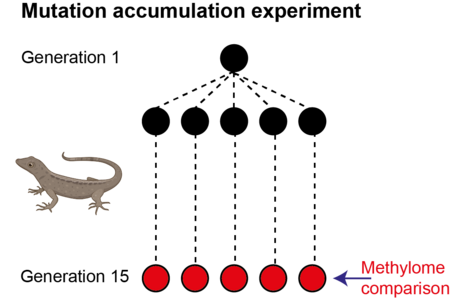Baumann/Huber/Xu
Epimutation rates in an asexually reproducing lizard
Supervisor: Peter Baumann
Co-Supervisor: Meret Huber, Shuqing Xu
Scientific Background
DNA methylation is a major epigenetic mark in both plants and animals. Yet, even within species, there is substantial variation which genomic sites are methylated. In plants, part of this intraspecific variation in DNA methylation is due to the accumulation of epimutations, i.e. the inheritance of spontaneous changes in the methylome across generations. Whether epimutations accumulate across generations not only in plants but also in animals is unclear.
Animals are hypothesized to not accumulate epimutations because in some animals, in particular mammals, the methylome is reset during gametogenesis and embryogenesis. However, resetting of the methylomes seems to be less complete in other animal lineages: for instance, methylome resetting seems to be absent or incomplete in Cnidaria and insects, and only present maternally in zebrafish. While maternal resetting of the methylome in vertebrates may prevent the accumulation of epimutations across generations, this hypothesis has not been tested to date.
The best way to assess whether epimutations accumulate across generations is through mutation accumulation experiments, ideally in a clonally reproducing or self-fertilizing species. In mutation accumulation lines, the offspring from a single ancestor are grown for many generations in the absence of selection, after which the methylomes of the last generations are compared. However, mutation accumulation experiments are rarely done in vertebrates, as most vertebrates have long generation times, reproduce sexually and do not self-fertilize.
We have established several species of lizards in the genus Aspidoscelis as model for an asexually reproducing vertebrates. We have sequenced and assembled high-quality, chromosome-level reference genomes and maintained lineages for up to 15 generations. This resource provides a unique opportunity to assess epimutation rates in an asexually reproducing vertebrate.
Project description
In this project, the student will assess epimutation rates in the clonally reproducing lizard species A. neomexicanus. You will address the following three key questions: i) Do epimutations accumulate across asexual generations in a lizard? ii) Are these epimutations independent of genetic mutations? iii) Do these epimutations alter gene expression?
To assess whether epimutations accumulate across asexual generations, we will sequence the methylome of mutation accumulation lineages of A. neomexicanus using whole-genome bisulfite and nanopore sequencing, and subsequently compare the methylomes of the terminal generations. To assess whether these epimutations are independent of DNA sequence variation, we will additionally assess underlying mutations using nanopore sequencing data, and subsequently confirm the mutations using Sanger sequencing. This will also provide insights into mutation rates in asexually reproducing vertebrates. Next, we will assess gene expression by transcriptome sequencing, and test whether epimutations at promoter regions are associated with altered gene expression. Taken together, this project will reveal whether vertebrates can accumulate epimutations across generations, and whether these may alter gene expression.
What you will learn
Bioinformatic analysis of DNA methylation and DNA sequence variation and gene expression based on short and long read sequencing methods. Furthermore, you will learn tools in molecular biology (e.g. DNA extraction, PCR, preparation of sequencing libraries).
Your qualifications
This PhD project relies mostly on bioinformatic analysis, but also requires molecular skills in the laboratory. We are thus looking for an enthusiastic PhD student with a solid background in bioinformatics or computational biology, and interest in embracing molecular tools in the laboratory.
Publications relevant to this project
Xu S, Stapley J, Gablenz S, Boyer J, Appenroth KJ, Sree KS, Gershenzon J, Widmer A, Huber M (2020) Low genetic variation is associated with low mutation rate in the giant duckweed. Nature Communications 10(1):1243. doi.org/10.1038/s41467-019-09235-5
Ho DV, Tormey T, Odell A, Newton AA, Schnittker RR, Baumann DP, Neaves WB, Schroeder MR, Sigauke RF, Barley AJ and Baumann P (2023) Post-meiotic mechanism of facultative parthenogenesis in gonochoristic whiptail lizard species. BioRxiv https://doi.org/10.1101/2023.09.21.558237
Newton, AA, Schnittker RR, Yu Z, Munday SS, Baumann DP, Neaves WB, Baumann P (2016) Widespread failure to complete meiosis does not impair fecundity in parthenogenetic whiptail lizards. Development. 143(23): 4486-4494. https://doi.org/10.1242/dev.141283
Lutes AA, Neaves WB, Baumann DP, Wiegraebe W, Baumann P (2010) Sister chromosome pairing maintains heterozygosity in parthenogenetic lizards. Nature464: 283-286. https://doi.org/10.1038/nature08818
